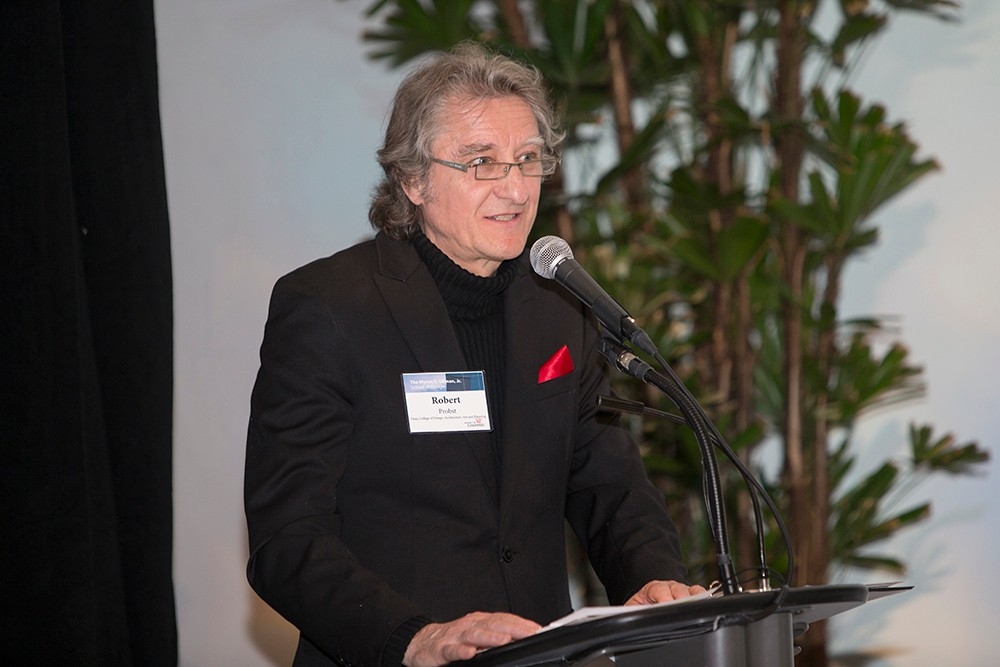Dean Robert Probst speaks at the Myron E. Ullman, Jr. School of Design naming event in April 2016. Photo/Andrew Higley/UC Creative Services
Outgoing DAAP dean looks to future commitment to campus
After stepping down from his current role on Sept. 14, Robert Probst is looking forward to a new title - simply being called 'Robert.' And with that title, he'll continue to serve, fostering UC's urban futures.
When Robert Probst stepped off an airplane in Cincinnati 40 years ago as a 27-year-old German-born designer, the city and the University of Cincinnati looked much different than they do today.
“This was a new frontier for both of us,” says Probst referring to his wife, Alison. The two designers met while studying at the College of Design Basel in Switzerland and married a short time later. Alison, who is of British descent, speaks both fluent German and English, while Probst spoke limited English at the time.
Shortly after graduating college, Probst landed a job with a prominent design firm near Munich. A few years later, he was approached by a former UC professor about a graphic design position at the College of Design, Architecture, and Art (now Design Architecture, Art, and Planning) — regarded in Europe as a premier design school.
“Back then I didn’t really have an interest in academia, but I went home and talked to Alison about it,” says Probst, who will step down as dean following the 2017-18 academic year. “We decided it was a new adventure for both of us, and we would give it a try, but only for one year.”
Probst’s wife Alison handled all the paperwork and university correspondence.
“She was a built-in translator for me, so I knew we would make it,” he says with a laugh.
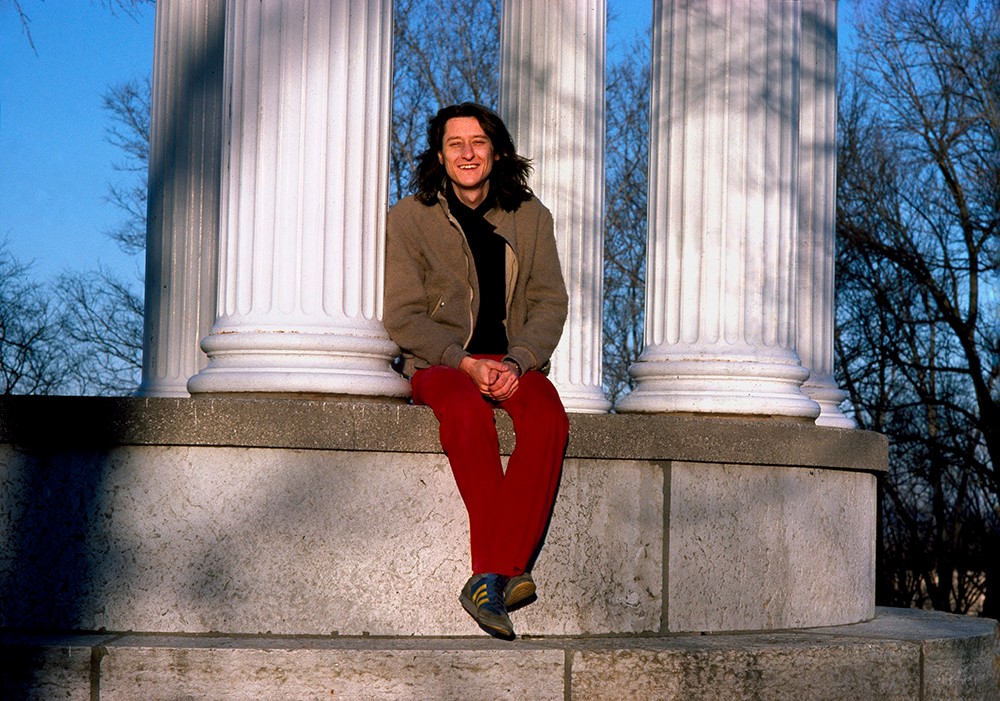
Probst sits under the "Temple of Love" pergola at Cincinnati's Mount Storm Park in 1978. Photo/Alison Probst
The Early Years
Probst and his wife packed up their belongings in two suitcases and headed to the Queen City. Their first stop: UC’s Morgens Hall.
“We had a one-bedroom apartment on the second floor overlooking the biggest parking lot you’ve ever seen,” he says. “It was dark, had two chairs and a bed but no sheets, so that night we covered ourselves with Alison’s poncho while we slept.”
The Morgens Hall Probst is referring to was built in 1964 on the corner of Martin Luther King Drive and Jefferson. In 2000, the university’s master plan called for the building to be razed and rebuilt. The new LEED-certified and award-winning Morgens Hall stands like a glass tower on the edge of UC’s campus, featuring 144 modern apartment units.
The next day the couple took a bus into downtown Cincinnati to do some shopping, explore the city core and prepare for their one-year stay.
“Downtown Cincinnati was very exotic to us,” says Probst. “We visited Fountain Square, shopped at McAlpin's and Elder-Beerman to buy things for our apartment, like sheets and utensils. There was a lot of good shopping and it was all very central to downtown.”
The University of Cincinnati today is much different than it was in the late '70s. Green lawns have replaced parking lots and unique architecturally designed buildings that have garnered international acclaim now sit where deteriorating buildings once stood. But to Probst, one thing has never changed.
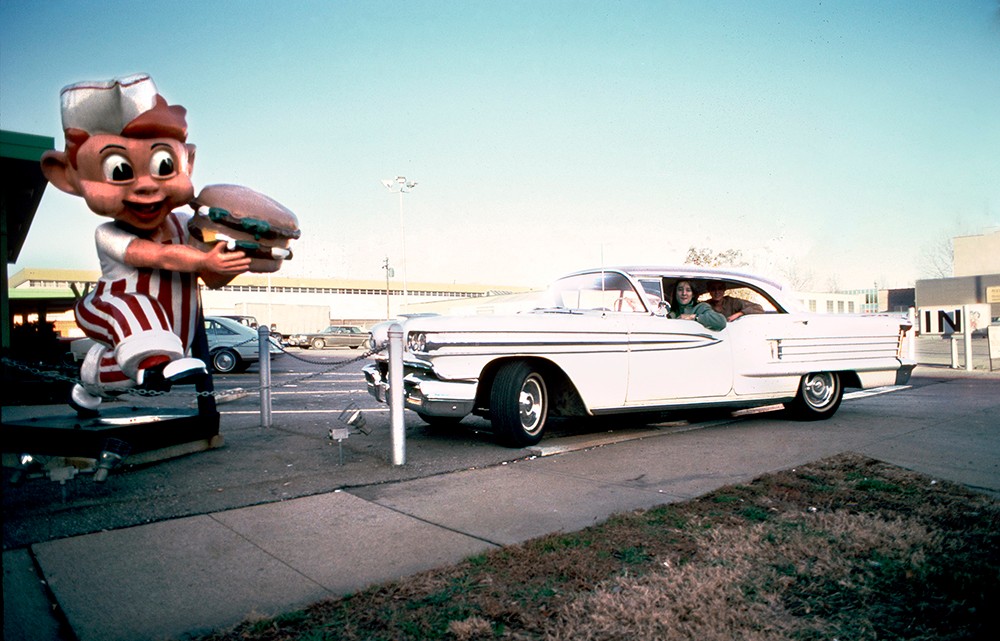
Probst sits in the first car he bought after moving to Cincinnati, which he still has today. Photo/provided
“My first memory of that first semester was the fall air," says Probst. “There is a certain smell in Cincinnati in September that comes back every year. I’ve never experienced it anywhere else. Each year I smell that same smell and I remember like it was yesterday.”
When Probst walked into his classroom in the fall of 1978, he quickly realized that he wasn’t much older than his students were and that his wife/translator would become his best classroom asset.
“I would talk and then she would translate my German critique into English so the students could understand me. But because Alison was also a designer, she would disagree with me sometimes. There we would be, standing in front of the class, arguing in German. But it was okay. The students enjoyed it. We made learning interesting and we became known for our friendly banter,” he says while laughing and shaking his head in near disbelief.
Alison would prove to be a key partner yet again when Probst was asked to teach a design history course.
“There weren’t a lot of books on the market about design history back in the late '70s and I didn’t really study design history,” says Probst. “It was rather avant-garde.”
Probst and his wife Allison rose to the challenge. They spent endless hours collecting thousands of images from art books to create lectures. They prepared the lectures together and worked two to three weeks ahead of the class.
“It was a wonderful time. She wasn’t paid for her work but it was our passion and we did it together. I still have those lectures.”
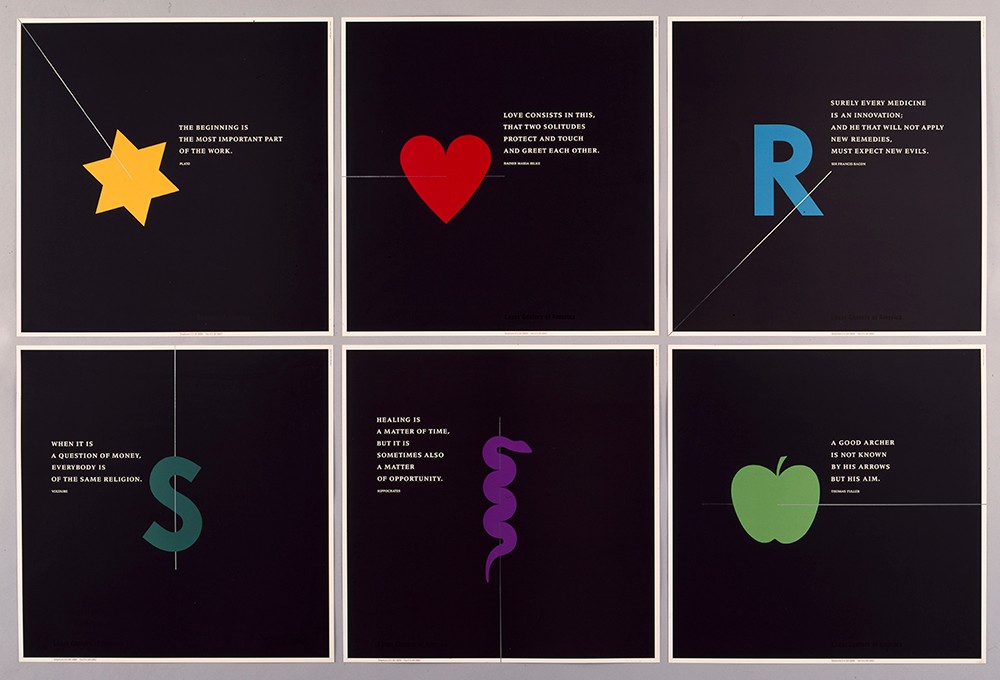
Probst’s award-winning promotional poster series designed for Laser Centers of America
The Design of a Leader
Following Probst’s first year of teaching he was recruited to stay on at UC and was moved into a tenure-track position by then-Dean Bertram Berenson, known as a colorful individual who expanded the college’s influence and reputation.
Probst was interested in collaborations with other disciplines and sponsored projects from the start. He pioneered interdisciplinary teaching at DAAP and rose through the ranks to full professor. In 2001, Probst was named Director of the School of Design. Under his leadership, the school became known as a global leader in design education and was rewarded with a $10 million gift from a private donor.
Probst was also instrumental in leading the university’s efforts in becoming a member of the international PACE network, Partners for the Advancement of Collaborative Engineering Education, resulting in an in-kind grant of $421 million.
In 2007, Probst was appointed interim dean and in 2008 was named dean of the college. As dean, he established a $2 million chair for the study of “Communication in the Environment” and raised funds in excess of $15 million to build a “center of urban futures.”
In 2010, he was selected as one of the nation’s top 25 design educators and administrators by the Design Futures Council.
In 2011, under Probst’s leadership, the university received designation as an “Ohio Center of Excellence for Design and Innovation.”
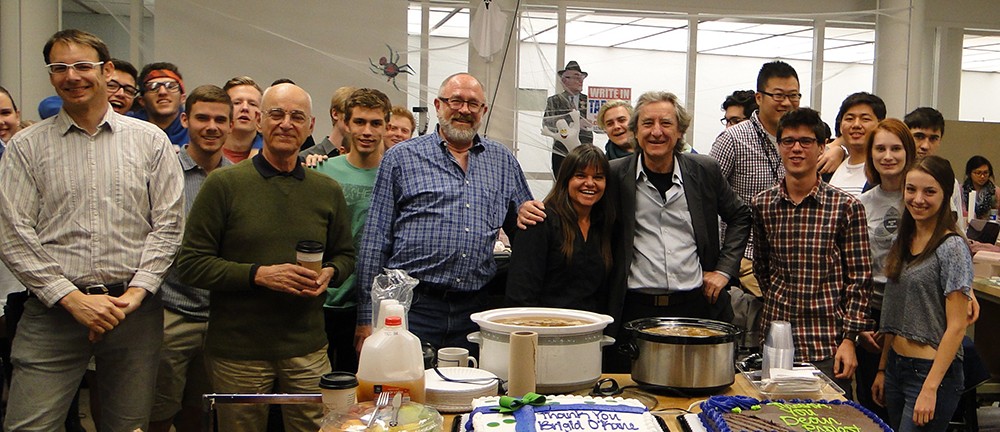
An impromptu potluck luncheon by industrial design students and faculty celebrates Interim School Director Brigid O’Kane and Dean Robert Probst. Photo/Jim Berns
Over the years he developed an international reputation as a designer and administrator. Probst’s academic and professional work has been featured in numerous national and international publications including “Masters of the 20th Century” by Mervin Kurlansky (The International Council of Graphic Design Association) and “Graphic Design since 1950” by Ben and Elly Bos (Alliance Graphique Internationale). His multidisciplinary work in communication design is included in permanent collections in New York, Tokyo, London and Zurich.
“There is a vibrancy in these hallways," he says. "The young people are hungry to learn and it is contagious. It is addictive because they all love what they do and they love being here. That energy has fed me for all these years.”
As has the commitment by DAAP alumni. As proof, he pulls out the latest DAAPworks catalogue with its collection of ten years of DAAPworks posters by graduates who are now in leadership positions at global design firms. These posters represent work by leaders at Pentagram, Apple, Nike, Target, Michael Graves Architecture and Design, Landor, Google, Facebook, LPK, and Under Armour.
“Whenever I call upon any of our alumni, they always respond,” he states.
Looking Forward with “Foggy Vision”
Probst says the one constant the University of Cincinnati has provided to him throughout his career is opportunity.
“It is what I am most proud of,” he says. “I had wonderful and supportive colleagues and this institution has given me many career milestones. Whenever something was new or developing, I was asked to give input. Opportunity will come to you when you are ready.” His three children Jasmine, Alistair and Lyndon graduated from UC with degrees in electronic media, urban planning and fine arts.
“I’ve invested 40 years into this institution,” he says. This has been my passion, but I am ready to start a new dimension in my life and career.”
And that new dimension will begin with Probst working part time to realize the potential of the Orville Simpson Urban Futures Center, to be located in the new 1819 Innovation Hub and integrated within the university’s strategic direction, Next Lives Here.
He explains, “The center will provide a platform and structure for research on urban futures, especially when it comes to support for faculty and students. I know I want to integrate our Simpson-related archival materials that are in storage with the University Archives and with the university’s arts collection.”
Beyond that, Probst laughs that he has “foggy vision,” which he says is a very good thing. “We should not always see too far into the future, and that’s a good thing. It keeps us flexible, ready to open new and unexpected doors. My life and service here at UC are a good example. I never planned to stay in Cincinnati, but I opened unexpected doors and had a great time.”
Become a Bearcat
In the DesignIntelligence survey of the nation’s employers who hire design and architecture grads, UC’s industrial design program is ranked No. 2 in the nation, interior design No. 4, and graduate-level architecture program has ranked in the nation’s top 20 for more than a decade. Apply to undergraduate programs in UC's College of Design, Architecture, Art, and Planning, or graduate programs in the college.

